________________
Introduction
5. JAYASENA : The Author In the concluding colophon the author mentions his name as Jayasepa qualified by Sri, Sūri, Mupi. His name can be taken as Jayasena rather than Sii-Jayasena. He traces his ancestry to Medārya (also written Metārya) who was the tenth Ganadbara of Mabāvīra.Medārya practised severe penance. He was a concrete embodiment of Dasadharma. He brought prosperity by his supernatural powers to the people in the town of Sri-khandilla. It is from him that the Sangha L(Jh)āļa Bāgada arose (tenājāyata). In that Sangha, in the line of great Saints, was born Dharmasena who used to preach the religion. After him comes Sāntişeņa a great disputant and well known for his learning. After him there was Gopasena, followed by Bhāvasena an embodiment of many virtues. His pupil was Jayasena. He was famous among the saints and gave pleasure to all the people. He composed this Sastra, i.e. Dharmaratnākara (DR), full of the essential doctrines of Jina-Samaya for the benefit of living beings. Thus Jayasena belongs to the Lāda Bāgada Sangha and his predecessors, in back succession were Bhāvasena, Gopasena, Säntisena and Dharmasena, going back to Medārya of antiquity.
It has been pointed out by Pt. Paramanand that a Ms. from Byavar contains an additional verse which specifies the date as well as place of composition :
बाणेन्द्रियव्योमसोममिते संवत्सरे शुभे।
ग्रन्थोऽयं सिद्धतां यातः सब (क)लीकरहाटके ॥ That means, this work was composed in Sam. 1055, i e., 998 A. D. Some read Sakali. and some Sabali - which is an elusive term; and the identification of the locality needs further inquiry.
Narendrasena gives a detailed Piaśasti at the end of his Siddhāntasāra-sangraha." It closely resembles the concluding section of DR both in contents and succession of teachers, and has in addition, some common verses. The inauguration of the Lāda Bāgada Sangha is attributed to Mcdārya, the tenth Ganadhara of Mahāvīra. The name of the locality with which he is associated is differently mentioned (Sri-khandil. laka-pattana or Śrī-pürņatalla). Then there is Dharmasena, a Digambara, who covered his body as it were with the garment of the lustre of his teeth in course of his discourses. What are the adjectives of Dharmasena in one get transferred to śāntisena in the other. The Editor has arranged the lines into verses without taking into
1) In some of the lists, the eleven Ganadharas are mentioned thus : (1) In. drabhūti, (2) Agnibhūti, (3) Vāyubbūti, (4) Akampana, (5) Maurya, (6) Sudharman, (7) Putra, (8) Mitra (Maitreya), (9) Mandya (Maudya), (10) Andhavela and (11) Prabhāsa (with some variation in the order). Medārya is not included here; but his name occurs in the list given in the Kalpasūtra (S. B. E. Vol. 22,
p. 286).
2) Jaina-Grantha-prasasti-samgraba, Part I, J. Mukthar and Paramananda, Virasevamandira, Delhi 1954, pp. 5 (Intro.) 3-4.
3) Ed. by Pandit Jinadas P. Phadkule, Sholapur 1957.




